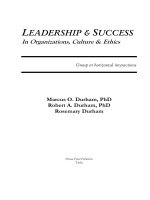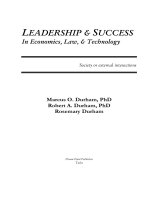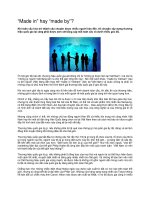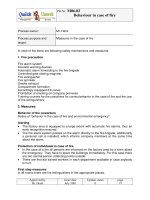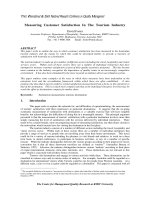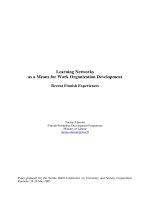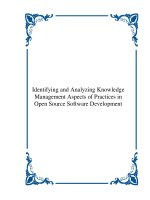Agile Technologies in Open Source Development ppt
Bạn đang xem bản rút gọn của tài liệu. Xem và tải ngay bản đầy đủ của tài liệu tại đây (4.14 MB, 388 trang )
Hershey • New York
InformatIon ScIence reference
Agile Technologies in
Open Source Development
Barbara Russo
Free University of Bozen-Bolzano, Italy
Marco Scotto
Free University of Bozen-Bolzano, Italy
Alberto Sillitti
Free University of Bozen-Bolzano, Italy
Giancarlo Succi
Free University of Bozen-Bolzano, Italy
Director of Editorial Content: Kristin Klinger
Senior Managing Editor: Jamie Snavely
Assistant Managing Editor: Michael Brehm
Publishing Assistant: Sean Woznicki
Typesetter: Christopher Hrobak
Cover Design: Lisa Tosheff
Printed at: Yurchak Printing Inc.
Published in the United States of America by
Information Science Reference (an imprint of IGI Global)
701 E. Chocolate Avenue,
Hershey PA 17033
Tel: 717-533-8845
Fax: 717-533-8661
E-mail:
Web site: />Copyright © 2010 by IGI Global. All rights reserved. No part of this publication may be reproduced,
stored or distributed in any form or by any means, electronic or mechanical, including photocopying,
without written permission from the publisher.
Product or company names used in this set are for identication purposes only. Inclusion of the
names of the products or companies does not indicate a claim of ownership by IGI Global of the
trademark or registered trademark.
Library of Congress Cataloging-in-Publication Data
Agile technologies in open source development / by Barbara Russo [et al.].
p. cm.
Includes bibliographical references and index.
Summary: “The aim of this book is to analyze the relationship between agile
methods and open source, presenting the basic principles and practices and
providing evidence through a set of specic empirical investigations”
Provided by publisher.
ISBN 978-1-59904-681-5 (hardcover) ISBN 978-1-59904-683-9 (ebook) 1.
Agile software development. 2. Open source software. I. Russo, Barbara.
QA76.76.D47A395 2009
005.1 dc22
2008054195
British Cataloguing in Publication Data
A Cataloguing in Publication record for this book is available from the British Library.
All work contributed to this book is new, previously-unpublished material. The views expressed in
this book are those of the authors, but not necessarily of the publisher.
Foreword ix
Preface xi
Section 1:
Comparing Agile and Open Source Development
Introduction 1
Chapter 1
Historical Evolution of the Agile and Open Source Movements 4
Agile Methods 4
The Win-Win Spiral Software Development Model 5
The XP Software Development Model 10
Open Source Software Development 13
Comparison of OS and Agile Development 19
References 20
Endnotes 22
Chapter 2
The Agile Manifesto and Open Source Software 23
Introduction 23
Principles of Agile Software Development 25
VTK Example 26
Conclusion 28
References 28
Endnotes 29
Table of Contents
Chapter 3
Values and Principles Practices in Agile and Open Source Development 30
Introduction 30
Values in Agile and in Open Source Development 31
Principles in Agile and in Open Source 33
Software Practices in Agile and in Open Source Development 35
Putting the Analysis Together 39
References 40
Endnote 40
Chapter 4
Models of Organization 41
Introduction 41
The Agile Manifesto 42
Culture, People, Communication 43
Goals of Organization Models for AMs and XP 43
Organization 46
Key Points for Organizations 48
References 49
Chapter 5
Coordination in Agile and Open Source 51
Introduction 51
What is Coordination? 52
Interdependencies and Coordination Mechanisms 54
Coordination and New Software Development Approaches 61
References 72
Endnotes 74
Chapter 6
Other Agile Methods 75
Introduction 75
Crystal 76
DSDM 79
LSD 83
References 89
Section 2:
Agile Software Practices for Open Source Development
Chapter 7
Testing 91
Introduction 91
Testing in the Open Source Development 92
Use of xUnit in Agile and OS Development 94
A Method to Reveal the Adoption of Test First in OS Projects 95
Adoption of Test First in Open Source Projects: A Manual Inspection 96
Tool Supporting the Repository’s Inspection 99
Excel Tool for the Analysis and Evaluation of Collected Metrics 116
Example of the Use of the Macro, CruiseControl_2.1.1 116
Manual Test First Analysis 119
References 122
Endnote 123
Chapter 8
Code Ownership 124
Introduction 124
Pareto Analysis 125
Adoption of Code Ownership in Open Source Development 125
References 132
Chapter 9
Design Approaches 133
Introduction 133
Agile Approaches to Design 134
Adoption of Big Upfront Design in Open Source Development 135
Time Series Analysis 136
References 142
Chapter 10
Case Studies 144
Introduction 144
The Eclipse Software Development Process 145
The Eclipse Software Development Process and the XP values and practices 150
The Funambol Release Life Cycle 151
References 155
Section 3:
Empirical Evaluations
Chapter 11
A Framework for Collecting Experiences 157
The Rationale 157
Structure of the Experience Framework 158
Standards for Data Collection 159
Standards for Data Analysis 167
Standards for the Set Up of Experiments 170
Standardization for the Generalization and Validation of the Results 176
How to use the Experience Framework: An Example of Repository 179
References 187
Endnote 188
Chapter 12
Improving Agile Methods 189
Motivation 189
Data Collection 194
Case Study I 198
Case Study II 205
Generalization 211
Methods for Assessing Generalization 212
Limitations of the Experiments 218
Summing Up 220
Final Considerations 222
Acknowledgment 227
References 227
Endnotes 231
Chapter 13
Effort Estimation 232
Effort Estimation in Agile Environments using Multiple Projects 232
Effort Estimation Models: An Overview 236
Comparative Analysis Using Two Case Studies 241
Model Building and Prediction 244
Summing Up 250
References 251
Endnote 255
Chapter 14
Discontinuous use of Pair Programming 256
Introduction 256
Structure of the Experiment 257
Results 262
Summing Up 266
References 267
Chapter 15
Requirements Management 268
Introduction 268
Background 269
Survey 274
Results 275
Discussion 280
Summing Up 283
References 284
Chapter 16
Project Management 287
Introduction 287
The Structure of the Investigation 288
Results 293
Summing Up 298
References 299
Endnotes 300
Section 4:
Industrial Adoption and Tools for Agile Development
Chapter 17
Open Source Assessment Methodologies 302
Introduction 302
Open Source Maturity Model (OSMM) from Cap Gemini 303
Open Source Maturity Model (OSMM) from Navica 305
Methodology of Qualication and Selection of Open Source Software (QSOS)
307
Open Business Readiness Rating (OpenBRR) 308
References 310
Chapter 18
Adoption of Open Source Processes in Large Enterprises 311
Introduction 311
The Study 312
Chapter 19
Trust Elements in Open Source 334
Introduction 334
Trustworthy Elements 337
Trustworthy Elements in Companies 340
References 342
Endnote 342
Chapter 20
Overview of Open Source Tools for Agile Development 343
Introduction 343
Version Control Tools 345
Automated Build Tools 348
Continuous Integration Tools 350
Issue Tracking Tools 351
Synchronous and Asynchronous Communication Tools 352
Project Management Tools 354
Testing Tools 355
Tools to Support Specic Agile Practices 356
Measuring Tools 360
Endnotes 361
Conclusion 362
Glossary 364
About the Authors 365
Index 367
ix
Foreword
This book approaches two contemporary topics in the eld of software engineer-
ing that have had more than a signicant impact in the way the modern software is
being developed. Agile movement raised the role of experience and people in the
centre stage having a profound impact on large and small software organizations
alike. Research and practice have shown that agile is penetrating practically in
all industrial domains including the globally operating, hardware-bound software
development.
Open source software development was considered to be outside of the scope
of professional software development practice for long time. Companies perceived
the voluntarily lead programming initiatives as something that could not be part of
their strategic goal setting or daily practice. Today, a great majority of the companies
utilize the open source solutions at many levels of the organization. The corporate
strategies often include a plan where part of the software product has been opened
for getting the benets that are associated with the open source communities.
There are many similarities in agile and open source movements. They have taken
the eld by surprise and gained a signicant momentum that bear long lasting impact
on the practice of software development. Both were initiated by a small group of
practitioners. They are based on a value structure, which is far from the traditional
technology orientation of many other software engineering innovations. Finally, the
two approaches value people, collaboration, and excellence as the primary drivers
of software development.
x
This book shows you that open source and agile both deal with operational ef-
ciency approaching it from different but mutually supporting angles. The authoring
team has done a great job in highlighting the key differentiators and similarities
of the two approaches. This book stands out from the others by presenting solid
empirical evidence to support authors’ argumentation. Practitioners will nd many
suggestions and guidance, and they can also see the rationale behind these ideas,
which further raises the value of this book.
Pekka Abrahamsson
Professor
University of Helsinki
Pekka Abrahamsson, PhD is a professor of computer science in University of Helsinki in Finland. He
leads large European research projects on agile software development in large systems development
settings. He has presented several key notes on agile software development in several international
conferences He has published more than 65 refereed publications in international journals and
conferences. His research interests are centered on agile software development, empirical software
engineering and embedded systems development. He leads the IEEE 1648 working group on agile
standardization and he was granted the Nokia Foundation Award in 2007. Dr. Abrahamsson is a
member of both IEEE and ACM.
xi
Preface
This book presents agile methods (AMs) and open source development (OSD) from
an unconventional point of view. Even if these two worlds seem very different,
they present a relevant set of similarities and dependences that are identied and
analyzed throughout the book.
The book is organized in four sections. The rst one introduces and compares
the agile and the open source (OS) movements analyzing their evolution, their main
values and principles, and their organizational models. The second section focuses
on some specic practices that are very relevant for both agile and OS movements
(testing, code ownership, and design), and presents two success stories of integrat-
ing such worlds into a single and successful development process. The third section
focuses on empirical studies. It introduces a framework for the collection and the
comparison of empirical evidences and a set of empirical studies performed on agile
and OS projects and teams. The chapters of this section focus on single aspects of
the development process and present data collected in different kinds of experiments
performed in different contexts. The last section aims at presenting topics relevant
for industrial adoption, such as methodologies for selecting OS solutions to adopt
in companies (agile and not) and presents a catalog of OS tools that are widely
used in agile development. Since the large number of tools available may confuse
practitioners and researchers interested in experimenting some of the techniques
presented, the section aims at describing assessment methodologies and providing
a reference set of tools from which people can start.
Part of this book has been based on the work done by the authors in the EU
funded project QualiPSo and the FIRB project ArtDeco.
This book is organized as follows:
• Section 1 makes a comparison between AMs and open source software devel-
opment (OSSD) investigating the founding principles.
• Section 2 focuses on a specic subset of practices through a deeper analysis
based on empirical evidences.
xii
• Section 3 presents a set of empirical evaluations performed in different settings
to verify the effectiveness of specic practices.
• Section 4 investigates industrial adoption of OS and tools available for the
agile development.
Section 1 includes the following chapters:
• Chapter 1: Historical Evolution of the Agile and Open Source Movements
○ The Win-Win Spiral Software Development Model
○ The XP Software Development Model
○ The Cathedral and the Bazaar
○ References
• Chapter 2: The Agile Manifesto and Open Source Software
○ Individuals Over Processes and Tools
○ Working Software Over Comprehensive Documentation
○ Customer Collaboration Over Contract Negotiation
○ Responding to Change Over Following a Plan
○ References
• Chapter 3: Values and Software Practices
○ Values in Agile and in Open Source
○ Principles in Agile and in Open Source
○ Software Practices in Agile and in Open Source Development
○ References
• Chapter 4: Models of Organization
○ Culture, People, Communication
○ Goals of Organization Models for AMs and XP
○ Organization
○ References
• Chapter 5: Coordination in Agile and Open Source
○ Interdependencies and Coordination Mechanisms
○ Coordination and New Software Development Approaches
○ References
• Chapter 6: Other Agile Methods
○ Crystal
○ DSDM
○ LSD
○ References
xiii
Section 2 includes the following chapters:
• Chapter 7: Testing
○ Introduction
○ Adoption of Test First in Open Source Development
○ Example: JUnit
○ References
• Chapter 8: Code Ownership
○ Introduction
○ Adoption of Code Ownership in Open Source Development
○ References
• Chapter 9: Design Approaches
○ Introduction
○ Adoption of Big Upfront Design in Open Source Development
○ References
• Chapter 10: Case Studies
○ The Eclipse Development Process
○ The Funambol Development Process
○ References
Section 3 includes the following chapters:
• Chapter 11: A Framework for Collecting Experiences
○ The Experience Framework
○ Data Collection
○ Data Analysis
○ Example of Application
○ References
• Chapter 12: Improving Agile Methods
○ Case Studies
○ References
• Chapter 13: Effort Estimation
○ Effort Estimation Models
○ Comparative Analysis
○ References
• Chapter 14: Discontinuous Use of Pair Programming
○ The Study
○ Results
○ References
xiv
• Chapter 15: Requirements Management
○ The Study
○ Results
○ References
• Chapter 16: Project Management
○ The Study
○ Results
○ References
Section 4 includes the following chapters:
• Chapter 17: Open Source Assessment Methodologies
○ OSMM from Cap Gemini
○ OSMM from Navica
○ QSOS
○ OpenBRR
○ References
• Chapter 18: Adoption of Open Source Processes in Large Enterprises
○ The Study
• Chapter 19: Trust Elements in Open Source
○ Trustworthy elements
○ Trustworthy elements in companies
○ References
• Chapter 20: Overview of Open Source Tools for Agile Development
○ Introduction
○ Version Control Tools
○ Automated Build Tools
○ Continuous Integration Tools
○ Issue Tracking Tools
○ Synchronous and Asynchronous Communication Tools
○ Project Management Tools
○ Testing Tools
○ Tools to Support Specic Agile Practices
○ Measurement Tools
Section I
Comparing Agile and Open Source
Development
1
Introduction
Agile Methods (AMs) are very recent but many of their basic principles are rather
old, inherited from the lean production pioneered in the ‘60s at Toyota for the pro-
duction of cars. Moreover, many practices on which AMs are based have a long
tradition in software development. For instance, unit testing has been used since
the ‘60s. However, one of the major achievements of AMs is the integration of all
these well established principles and practices with some others more recent such
as pair programming.
The Open Source (OS) movement has a long tradition as well. However, it was
born as a way of licensing software not as a development method. Moreover, people
producing OS software use a wide range of different approaches to software devel-
opment. Even if, it is not possible to dene a single OS development method, there
are some basic principles and approaches that have become common in several OS
communities.
Surprisingly or not, there are many basic principles and development techniques
that are similar in AMs and OS Software Development (OSSD). As an example
further investigated in the rst section of this book, the three of the four principles
of the AMs are completely embraced by OSSD.
The analysis of commonalities and differences between AMs and OSSD is at
the beginning but it is interesting to understand how some development approaches
2 Introduction
Copyright © 2010, IGI Global, distributing in print or electronic forms without written permission of IGI Global
is prohibited.
have evolved during the time and whether they produce concrete benets in terms
of software quality and customer satisfaction.
This book is a rst attempt in the investigation of such relationship through of
the analysis and the comparison of the basic principles and practices, the discus-
sion of some empirical evaluations, and the presentation of promising assessment
methodologies.
This book addresses three main audiences: managers, researchers, and students.
In this book, managers can nd the basic principles and practices that are the
base for AMs and OSSD, how they are related to each other, and how the organiza-
tion of the work is affected. Moreover, the last section related to industrial adoption
guides the reader into the main aspects to consider in using such technologies in a
business environment.
Researchers can nd not only a theoretical analysis of the phenomena of AMs
and OS, but also the denition of an experimental framework for data collection
and analysis and a set of empirical investigations.
This book can be used by software engineering students in BSc and MSc courses
as a starting point to study how AMs and OSSD approaches the development proc-
ess and how they are related to each other.
Besides the references listed in each chapter, here below the reader can nd a
small set of additional readings:
• Section1: AMs and OSSD
○ Coplien, J. O., & Schmidt, D. (2004). Organizational Patterns of Agile
Software Development. Prentice Hall.
○ Goth, G. (2007). Sprinting toward Open Source Development. IEEE
Software, 24(1).
○ Koch, S. (2004). Agile Principles and Open Source Software Development:
A Theoretical and Empirical Discussion. In Eckstein, J., & Baumeister,
H. (Eds.) Extreme Programming and Agile Processes in Software Engi-
neering (pp. 85-93). Springer.
○ Mellor, S. (2005). Adapting agile approaches to your project needs. IEEE
Software, 22(3).
○ Stamelos, I. G., & Panagiotis, S. (Eds.). (2007). Agile Software Develop-
ment Quality Assurance. IGI Global.
• Section2: Analysis of Practices
○ Appleton, B., Berczuk, S., & Cowham, R. (2005). Branching and Merg-
ing: An agile perspective. CM Journal. Retrieved November 11, 2008
from: />Introduction 3
Copyright © 2010, IGI Global, distributing in print or electronic forms without written permission of IGI Global
is prohibited.
○ Cockburn, A., & Williams, L. (2001). The Costs and Benefits of Pair
Programming. In Succi, G., & Marchesi, M. (Eds.) Extreme Program-
ming Examined (pp. 223-248). Addison-Wesley Professional.
○ Davis, R. (2005). Agile requirements. Methods & Tools, 13(3).
○ Poole, C. J. (2004). Distributed product development using extreme pro-
gramming. In Eckstein, J., & Baumeister, H. (Eds.) Extreme Programming
and Agile Processes in Software Engineering (pp. 60-67). Springer.
○ Turnu, I., Melis, M., Cau, A., Marchesi, M., & Setzu, A. (2004). Intro-
ducing TDD on a free libre open source software project: a simulation
experiment. 2004 Workshop on Quantitative Techniques For Software
Agile Process.
• Section3: Empirical Evaluations
○ Cordeiro, L., Mar, C., Valentin, E., Cruz, F., Patrick, D., Barreto, R., &
Lucena, V. (2008). An agile development methodology applied to em-
bedded control software under stringent hardware constraints. SIGSOFT
Software Engineering Notes, 33(1).
○ Hazzan, O., & Dubinsky, Y. (2006). Can diversity in global software
development be enhanced by agile software development? 2006 Interna-
tional Workshop on Global Software Development For the Practitioner.
Shanghai, China.
○ Racheva, Z., & Daneva, M. (2008). Using measurements to support
real-option thinking in agile software development. 2008 International
Workshop on Scrutinizing Agile Practices Or Shoot-Out At the Agile
Corral, Leipzig, Germany.
○ Rumpe, B., & Schroder, A. (2002). Quantitative Survey on Extreme Pro-
gramming Project, 3rd International Conference on eXtreme Programming
and Agile Processes in Software Engineering (XP 2002).
○ Turnu, I., Melis, M., Cau, A., Setzu, A., Concas, G., & Mannaro, K.
(2006). Modeling and simulation of open source development using an
agile practice. Journal of System Architecture, 52(11).
• Section4: Industrial Adoption
○ Cohn, M., & Ford, D. (2003). Introducing an Agile Process to an Orga-
nization. IEEE Computer, 36(6).
○ Hansson, C., Dittrich, Y., Gustafsson, B., & Zarnak, S. (2006). How agile
are industrial software development practices? Journal of Systems and
Software, 79(9).
○ Hodgetts, P., & Phillips, D. (2001). Extreme Adoption Experiences of a
B2B Start-up. Retrieved November 11, 2008 from: lelogic.
com/files/eXtremeAdoptioneXperiencesofaB2BStartUp.pdf
○ Martin, K., & Hoffman, B. (2007). An Open Source Approach to Devel-
oping Software in a Small Organization. IEEE Software, 24(1).
4 Historical Evolution of the Agile and Open Source Movements
Copyright © 2010, IGI Global. Copying or distributing in print or electronic forms without written permission of IGI Global is
prohibited.
Chapter 1
Historical Evolution
of the Agile and Open
Source Movements
1.1 AGILE METHODS
Agile Methods (AMs) were born in the mid 1990s as part of a reaction against
“heavyweight methods” (also called plan-driven methodologies) like the waterfall
model. Heavyweight processes were seen as bureaucratic, slow, and inconsistent
with the business needs. Initially, AMs were called lightweight methods; in 2001,
prominent members of the raising community met in Utah and decided to adopt
the name Agile Methods. Later, some of these people formed the Agile Alliance, a
non profit organization that promotes Agile development. Early AMs, established
before 2000, include Scrum (1986), Crystal Clear, Extreme Programming, Adaptive
Software Development, Feature-Driven Development, and DSDM. Even if Extreme
Programming (XP) was not the first Agile Method, it established their popularity. XP
was created in 1996 by Kent Beck as a way to rescue the Chrysler Comprehensive
Compensation (C3) project. The aim of this project was to replace several payroll
application of Chrysler Corporation with a single system.
DOI: 10.4018/978-1-59904-681-5.ch001
Historical Evolution of the Agile and Open Source Movements 5
Copyright © 2010, IGI Global. Copying or distributing in print or electronic forms without written permission of IGI Global is
prohibited.
1.2 THE WIN-WIN SPIRAL SOFTWARE DEVELOPMENT MODEL
The Win-Win spiral software development model (Boehm & Bose, 1994) is based on
the ground-braking work of Barry Boehm, the first software engineering researcher
to formalize an agile process. It is based on two pieces of research elaborated by
Barry Boehm:
The Win-Win approach to requirement negotiation (Boehm • et al., 1994)
The spiral software development model (Boehm, 1988)•
1.2.1 The Win-Win Approach to Requirement Negotiation
Requirement negotiation is a very critical part of the software development pro-
cess; it deals with the elicitation of the desires of customer and with the negotiation
of what needs to be developed. Often, during such negotiation critical situations
emerge, where the desires of the customers clash with what the developers think it
is important and feasible to do. In such circumstances, the risk is high for the project
to go nuts or, even worse, for the developer to say “yeah!” to the customer or to the
manager, just to keep his or her position while looking for another job. The former
is risky because, at the end, the software developers needs a customer, otherwise
money will not come. The latter is terrible, as for sure the functionality will not
be delivered to the customer. Moreover, more money will be wasted. “Customers
are always right.” Well, this is what old-fashioned marketing books tell us. This
is true in the sense that the customer pays the bill. Therefore, s/he has the right to
get value for his or her money. However, for the customer to be always right, two
provisions are necessary:
The developer understands fully what the customer wants, and acts •
accordingly.
The customer understands fully what the developer can provide him or her in •
the time framework and with the money given, and acts accordingly.
If such provisions are not met and we still proceed, we are in a loose-loose situa-
tion:
The developer looses her or his jobs and gets a bad reputation.•
The customer wastes her or his time, and, sometimes, even his or her money •
and reputation.
6 Historical Evolution of the Agile and Open Source Movements
Copyright © 2010, IGI Global. Copying or distributing in print or electronic forms without written permission of IGI Global is
prohibited.
Now, there are two possibilities. First, the positions of the developer and the
customer cannot be accommodated together. In such circumstances, it is better to
acknowledge that there is no sense in proceeding with any agreement. Second,
the positions can be accommodated. In such case, we would like to find a way to
identify such point of accommodation with mutual benefit, the win-win point. The
win-win approach to requirement negotiations is a process that aims at ensuring that
the two provisions are satisfied whenever possible, leading to a win condition for
the customer, who gets the job done, and a win condition for the developer, who is
paid and builds up a good reputation.
The key idea is to try to make the process as transparent as possible, so that if a
win-win condition exists, it can be found and implemented. This is accomplished
using various kinds of tools. We describe the process; we define steps to make it as
objective as possible; we eliminate cultural barriers; and we put together customer
and developer. Among the tools to use, there are diagrams detailing the negotia-
tion process, like the ones available at />EasyWinWin.
In such diagrams, for instance, it is evidenced that there the process of defining
an agreement between a labor provider, the customer, the funds provider, and the
customer. The customer has issues s/he wants to solve. There are several alterna-
tives on how to address the issue. Our goal is to find that alternative that not only
addresses the issue to solve, but that can be carrier out with satisfaction by the de-
veloper. Such alternative, if it exists, is for us the win-win condition. It satisfies both
the customer and the developer. An agreement is a set of such alternatives. Well…
isn’t here something missing? Where is the manager? After all, the customer does
not talk directly with the development usually, s/he talks to a marketing person,
who then refers the issues for development to a manager.
Here there is yet another aspect of the wickedness of software development. The
manager is indeed important. However, a satisfactory negotiation does require the
presence of also the developer, or a person very much knowledgeable of what is
going on, otherwise the risk is high, not to be able to build a solid relationship.
1.2.2 The Spiral Development Model
The incremental software development model has the advantage of focusing on
small increments, making easier for developers to understand what happens at the
different stages and so on. One of the major limitations of this model lied on its
inability to involve the customer in the planning of the iterations. On one side, the
presence of the customer is beneficial as it helps the team to be in sync with his or
her desires. On the other side, the presence of the customer may become detrimental
in incremental model. The customer may not understand why effort is placed for a
Historical Evolution of the Agile and Open Source Movements 7
Copyright © 2010, IGI Global. Copying or distributing in print or electronic forms without written permission of IGI Global is
prohibited.
long time on issues whose relevance s/he is not able to capture. The main idea of
Barry Boehm has been to propose alternative. Try to slice the increments to develop
not in terms of the inner functionality, but by the functions deployed to the customer.
The model is called spiral, as:
At each “increment”… well “iteration,” or “ring of the spiral” we get a more •
complete version of the system to develop and
At each increment we repeat everything, including the interactions with the •
customer.
The key issue is that the ring is a portion of the system that does something useful
for the customer. Each ring should not require the building of the entire infrastruc-
ture; otherwise, it would be just a waterfall development! Each ring, though, should
contain functionalities that are useful to the end customer. Such functionalities may
need a portion of the overall infrastructure. Altogether, it is not easy to identify the
rings of the spiral. It requires a deep understanding of the system to build and an
extensive interaction with the customer, so that a “reasonable” ring can be produced.
To simplify the process we could use the win-win approach that we discussed earlier.
This is what is called the win-win spiral method (Figure 1).
It is important to remember that the spiral software development model is a
“model,” that is, is not a process itself. Rather, different processes can be built on
its basis. In Figure 1, there is the description of a sample process built on the spiral
model. Again, this is an implementation of the general win-win spiral model. The
model can be implemented very differently in various contexts.
The sample model entails the following eight steps:
1. Identification of the stakeholders of the ring to develop. This involves the
customers, or the portion of them that relates to what to do next.
2. Determination of the win-win condition: here customers, developers, and, if
needed, managers evaluate if a win-win condition exists and, if so, they develop
it.
3. Analysis of what to build on the basis of the identified win-win condition – in
the picture we omit the way out that occurs if the win-win condition does not
exist. Here we need to reconcile what to build with what has already been
built. Clearly, we want to develop an analysis performed on the top of what
is already there and we do not want to restart everything from scratch.
4. Design of what to build on the basis of the identified win-win condition. Also
in the case, we want to extend the previously built design. Definitely, redoing
everything from scratch is not to be considered.
8 Historical Evolution of the Agile and Open Source Movements
Copyright © 2010, IGI Global. Copying or distributing in print or electronic forms without written permission of IGI Global is
prohibited.
5. Coding of what to build on the basis of the identified win-win condition. Here
it is extremely important to extend the previous functionalities and not restart.
Redoing everything is not an option now.
6. Test of the new ring alone and within the entire system developed so far.
7. Evaluation with the customer of the new version of the system built so far.
8. Commitment of the work done so far.
This sample model evidences once more the critical issue of building the sys-
tem ring by ring. The first ring, the “nucleus,” is especially critical. The nucleus
requires: a) a good general understanding of what to develop and b) the ability to
build a system that does not commit “too much” the future developers in terms
of architectural and design lock-ins. Note that in the spiral model the customer is
involved in each ring.
Each ring in the spiral can then be organized in a V-shaped manner, quite like the
incremental model. Likewise, an object oriented approach appears an ideal match for
the spiral model, for the same reasons listed in the incremental model plus the easier
understandability on the side of the customer of part of the object oriented models,
Figure 1. Structure of the win-win spiral development model
